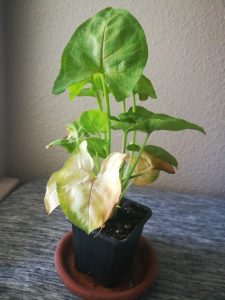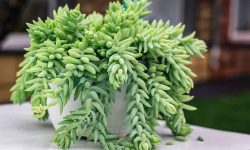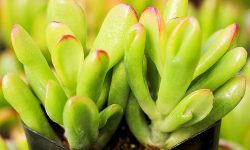Are your arrowhead plant leaves turning white and dying? This can be worrying since indoor plant leaves turning white is a rare phenomenon. Take the time to investigate the growing environment and conditions to determine the exact cause.
Identifying the exact causes of plant leaves turning white on edges can be a daunting experience for beginners. We recommend reading this article up to the end to identify the common causes and their respective solutions.

Causes of Arrowhead Plant Leaves Turning White
Arrowhead Leaf Disease
Arrowhead plant leaves turning white can be a symptom of bacterial leaf spots. This disease is caused by the bacteria Xanthomonas campestris. The bacteria infect the leaves, causing small, water-soaked lesions that eventually turn white or light gray.
It is important to act promptly. Remove and destroy infected leaves to prevent the spread of bacteria. Ensure good air circulation around the plant by providing adequate spacing between plants. Avoid overhead watering, as it can promote the spread of the bacteria.
We recommend watering at the base of the plant to keep the foliage dry. Applying a copper-based fungicide or bactericide can help control the disease, but it’s essential to follow the instructions carefully.
Maintain a clean environment by removing fallen leaves or debris that may harbor bacteria. Avoid overcrowding plants and ensure they receive adequate light, as this promotes plant vigor and disease resistance. Regularly inspect your plants for any signs of disease or pests.
Direct Sunlight Exposure
Excessive direct sunlight exposure can cause arrowhead plant leaves to turn white due to sunburn. Arrowhead plants prefer bright, indirect light but are sensitive to intense, direct sunlight. When exposed to prolonged periods of direct sunlight, the leaves may develop white or yellow patches.
Provide your arrowhead plant with filtered or diffused light. Place the plant in a location where it receives bright, indirect light, such as near a north or east-facing window. If direct sunlight is unavoidable, use sheer curtains or blinds to filter the light.
Low Lighting Conditions
Insufficient light can also cause arrowhead plant leaves to turn white or pale. Arrowhead plants require moderate to bright indirect light to thrive. When they don’t receive enough light, their leaves may lose their vibrant green color and become pale or even white.
Move your arrowhead plant to a brighter location with indirect light. Consider placing it near a window that receives moderate to bright light but avoid exposing it to direct sunlight. If natural light is limited, you can supplement it with artificial grow lights.
Edema Problem
Edema occurs when the arrowhead plant’s roots absorb more water than the leaves can transpire, leading to waterlogged cells and subsequent damage. As a result, the leaves may develop blister-like formations or turn white.
Ensure proper watering practices. Allow the top inch of soil to dry out before watering again to prevent overwatering. Provide adequate drainage for the plant by using well-draining soil and a container with drainage holes.
Avoid misting the leaves excessively, as this can contribute to increased humidity and water retention. Maintaining proper humidity levels (around 50%) can also help reduce the risk of edema. If edema has already occurred, adjust watering practices and improve air circulation to aid in the healing process.
Nutritional Deficiency
Nutritional deficiencies, particularly in essential nutrients like nitrogen, iron, or magnesium, can cause arrowhead plant leaves to turn white. These deficiencies affect the plant’s ability to produce chlorophyll, resulting in chlorosis or whitening of the leaves.
Provide balanced fertilizer to your houseplant. Choose a high-quality, balanced liquid fertilizer specifically formulated for houseplants. Follow the recommended dosage and application frequency provided on the fertilizer label.
Regularly feed the arrowhead plant during the growing season (spring and summer), reducing or ceasing fertilization during the dormant period (fall and winter). Consider incorporating organic matter, such as compost or well-rotted manure, into the soil to improve its nutrient content.
Wrong Soil pH
An incorrect soil pH can interfere with nutrient availability and uptake, leading to nutrient deficiencies and subsequently causing arrowhead plant leaves to turn white. Arrowhead plants prefer slightly acidic to neutral soil with a pH ranging from 5.5 to 7.
Test the soil using a pH testing kit or meter. If the pH is outside the recommended range, adjust it accordingly. To increase acidity, incorporate organic matter like peat moss or coffee grounds into the soil. If the soil is too acidic, add lime to raise the pH gradually.
Follow the product instructions for the appropriate amount to use. Monitor the pH regularly and make adjustments as necessary to maintain the optimal range.
Poor Water Quality
Poor water quality contains high levels of chlorine, fluoride, or salts that can cause leaf discoloration in arrowhead plants. These chemicals can accumulate in the soil, affecting nutrient absorption and causing leaf damage.
Use filtered or distilled water for watering your arrowhead plant. You can also fill a watering can and let it sit for 24 hours to allow the chlorine to dissipate before using it. If your tap water has high fluoride or salt content, consider using rainwater or collected water from a dehumidifier.
Regularly flush the soil by watering the plant until water drains freely from the bottom of the pot. This helps remove accumulated salts and maintain soil health.
Pest Infestation
Certain pests, such as spider mites or whiteflies, can infest arrowhead plants and cause damage to the leaves, leading to discoloration, including whitening. These pests feed on the plant’s sap, weakening it and affecting its overall health.
Regularly inspect your arrowhead plant for any signs of pests, such as tiny webs, sticky residue, or small flying insects. If pests are detected, isolate the plant to prevent the infestation from spreading to other plants.
Depending on the severity of the infestation, you can use natural remedies like insecticidal soap or neem oil to control the pests. Follow the instructions on the product label for safe and effective application. Consult a professional gardener or horticulturist for further assistance in severe cases.
Indoor Temperature Fluctuations
Sharp fluctuations in indoor temperatures can stress arrowhead plants, leading to leaf discoloration. Sudden drops or rises in temperature can disrupt the plant’s metabolic processes and affect its overall health.
Place your arrowhead plant in a location with stable temperatures, avoiding areas near drafty windows, heating vents, or air conditioning units. Maintain a consistent indoor temperature range suitable for the plant, ideally between 60°F and 75°F (15°C and 24°C).
Avoid exposing the plant to cold drafts or sudden temperature changes. If necessary, use a thermometer to monitor the temperature in the plant’s vicinity and make adjustments accordingly, such as relocating the plant to a more suitable area within your home.
Final Thoughts from Expert
Arrowhead plant leaves turn white due to diseases and improper nutrients. Other possible causes are poor water quality, insect infestation, and edema. Take the time to examine your indoor arrowhead plant to identify the exact cause and fix it.
Be sure to cut off the white leaves since it will prevent the issue from spreading. Provide ultimate arrowhead plant care to prevent the leaves from turning white. Share with us your experience in dealing with Syngonium plant leaves turning white in the comment section.
People Who Read This Also Read:






